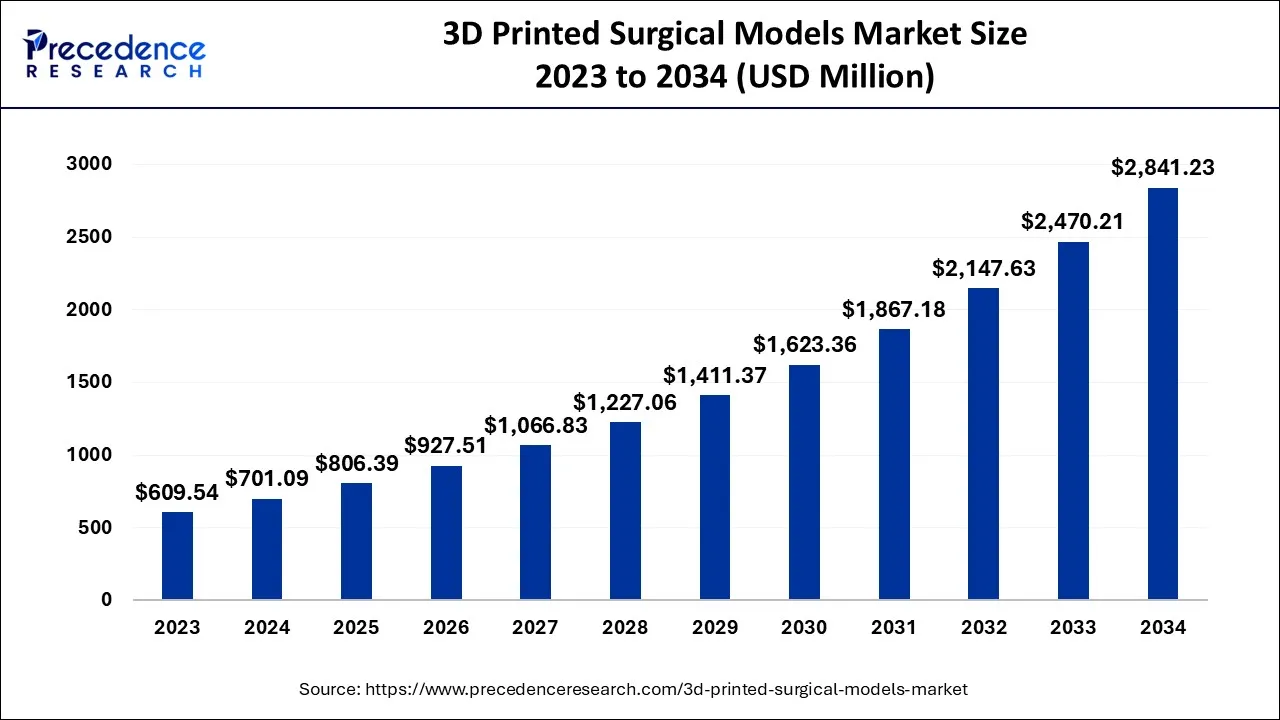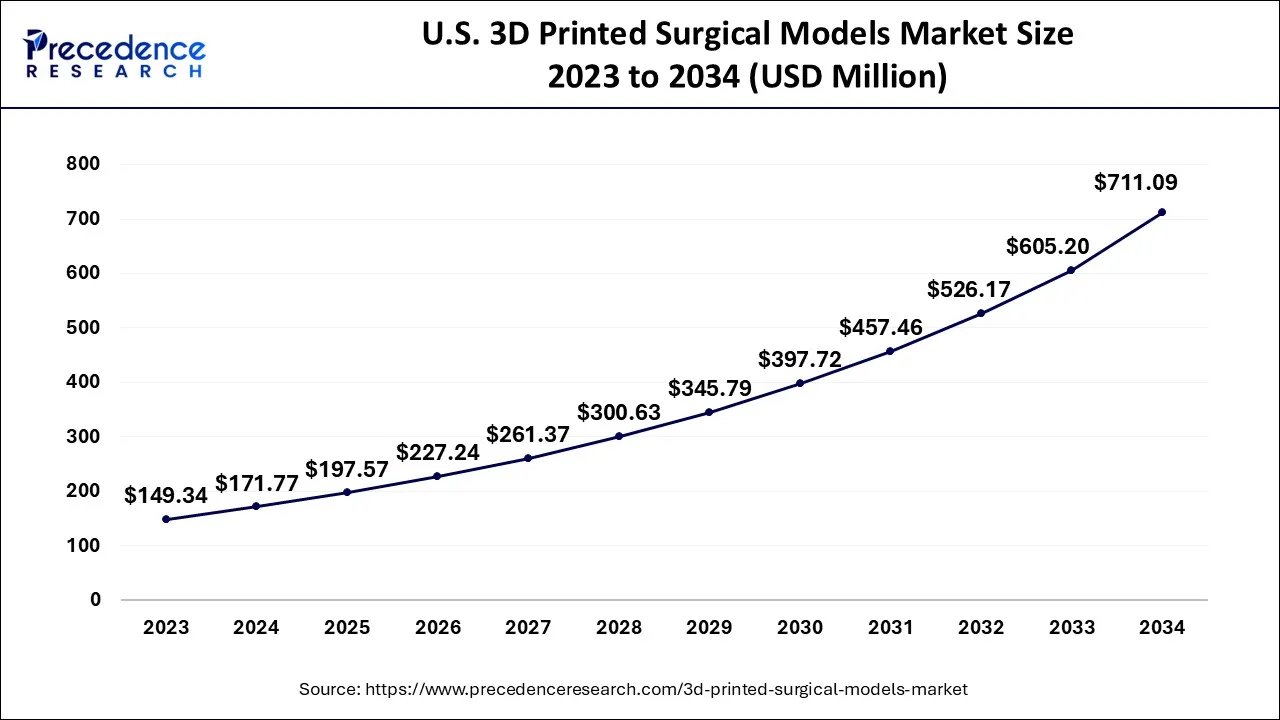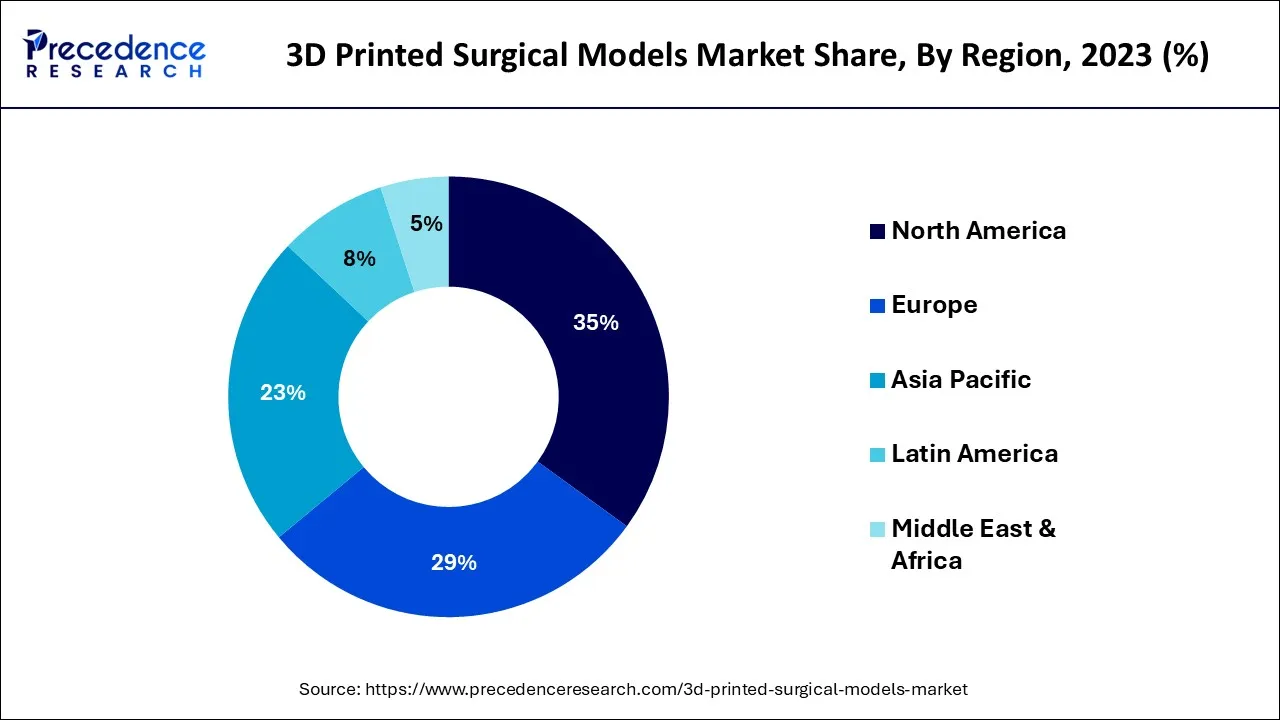List of Contents
3D Printed Surgical Models Market Size and Forecast 2024 to 2034
The global 3D printed surgical models market size is expected to be valued at USD 701.09 million in 2024 and is anticipated to reach around USD 2,841.23 million by 2034, expanding at a CAGR of 15.02% over the forecast period from 2024 to 2034.

3D Printed Surgical Models Market Key Takeaways
- North America dominated the market and generated more than 35% of the revenue share in 2023.
- By Specialty, the orthopedic surgery segment captured more than 33% of the revenue share in 2023.
- By Technology, The fused deposition modeling (FDM) segment is expected to expand at a remarkable CAGR between 2024 and 2034.
- By Material, the plastics material segment generated more than 34% of total revenue in 2023.
U.S. 3D Printed Surgical Models Market Size and Growth 2024 to 2034
The U.S. 3D printed surgical models market size is exhibited at USD 171.77 million in 2024 and is projected to be worth around USD 711.09 million by 2034, growing at a CAGR of 15.27% from 2024 to 2034.

In 2023, North America dominated the global industry, accounting for more than 35% of overall revenue. According to forecasts, the local market will grow due to a rising geriatric population and the high frequency of illnesses associated with sedentary living. The region's growth will be driven by the most progressive healthcare set-up, including clinics and clinics, and extensive use of cutting-edge medical amenities and products such as 3D printing.

A favorable compensation system and the presence of well-established participants are expected to increase the region's industry share. In Asia Pacific, the industry is expected to grow significantly in the coming years. The demand for 3D-printed surgical models is likely to rise due to rising per capita income levels, significant unmet medical needs, technological advancements, and the economic development of emerging nations such as India and China.
3D Printed Surgical Models Market Growth Factors
As a result of increased demand for high-tech advancements in surgical instruments, techniques, 3D printed resources, and individualized healthcare, the market for 3D printed surgical models has grown. The medical industry's use of 3D-printed surgical models for the preparation of endovascular aneurysm restoration, tumor excision, and the treatment of trauma damages in orthopedic operations has improved market statistics for 3D-printed surgical models.
The market is expanding due to technological advancements and advances in medical sciences. An aging population and a global demand for nominally invasive surgery drive the industry share. On the other hand, the high rate of technology is expected to limit demand. Increased use of refurbished and recycled equipment will likely constrain industry growth during the forecast period. The pandemic has reduced demand for goods and equipment, affecting innovative investments in the healthcare area.
Market Scope
| Report Coverage | Details |
| Market Size in 2024 | USD 701.09 Million |
| Market Size by 2034 | USD 2,841.23 Million |
| Growth Rate from 2024 to 2034 | CAGR of 15.02% |
| Largest Market | North America |
| Base Year | 2023 |
| Forecast Period | 2024 to 2034 |
| Segments Covered | Specialty, Technology, Materials, and Region |
| Regions Covered | North America, Europe, Asia-Pacific, Latin America and Middle East & Africa |
Market Dynamics
Drivers
Increased prevalence of osteoarthritis and other musculoskeletal conditions driving the market growth
One of the major factors driving the growth of the 3D printed surgical models market is the increasing prevalence of osteoarthritis and other musculoskeletal conditions. Osteoarthritis is a condition that causes pain, stiffness, and loss of joint function by damaging the joint cartilage and surrounding tissues. 3D printing medical devices enable the creation of a replica of a patient's joint, which can provide surgeons with critical information that a 2-dimensional scan may not reveal.
The probability of developing osteoarthritis rises with age. According to the US National Library of Medicine, by 2040, it is expected that approximately 78 million (26%) US adults aged 18 and above will have doctor-diagnosed arthritis. As a result, the adoption of 3D-printed medical devices is increasing, positively impacting market growth.
Restrains
Regulatory challenges restrain the market growth
The regulation on 3D Printed surgical model products hinders the industry growth. Bioprinter tissue is a "custom-made device" due to the high degree of personalization in construct shape and genetic material. The addition of biological material complicates matters, and regulatory bodies worldwide, such as the FDA, need to catch up with the rapidly evolving field of bioprinting, with currently unclear guidance and regulations for such technology.
The classification and ultimate regulation of regenerative medicine and tissue-engineered technologies and their components is challenging in all design, production, and handling aspects. These technologies' seemingly never-ending innovation and advancement exemplify the convergence of several different pathways covering a broad taxonomy of perceived utility, cost-effectiveness, and biography.
Opportunities
Increase the use of patient-specific implants future for 3D-printed surgical models
Patient-specific Implant is the most recent and progressive application of 3D printing in the surgical field. Based on accurate 3D imaging, patient-specific implants are planned, resulting in perfectly fitting implants that restore appropriate anatomy, relation, and function. In craniomaxillofacial surgery, PSI is becoming increasingly popular, with many companies offering various implants made of multiple materials for operation and restoring anatomy and symmetry.
Titanium implants combined with autogenous bone grafts for load-bearing reconstruction following mandibular resections and avulsion injuries and personalized PSI integrated with dental implants for future dental arch and occlusion restoration.
In orthopedics, patient-specific implants were used for bony reconstruction following tumor resections, the production of customized external fixators used in fracture treatment, and cervical spine renovation. To repair skull defects, PSI technology is also used in neurosurgery, primarily in cranioplasty. PSI results in a more precise and long-lasting reconstruction method, with less morbidity and a shorter operation time.
Specialty Insights
The orthopedic surgery segment dominated the global industry, accounting for more than 33% of the total revenue share in 2023. The growing elderly population and the rising prevalence and incidence of orthopedic ailments are the primary factors influencing the market growth of orthopedic surgery.
According to the WHO, around 1.71 billion people worldwide suffer from musculoskeletal disorders. Lower back pain is the foremost cause of disability in 160 countries, and musculoskeletal diseases are the leading cause of disability globally. The neurosurgery segment is expected to grow rapidly during the forecast period. This is due to technical advancements in 3D printing methods and materials, the increasing incidence of neurological diseases, and the delicate architecture of the brain's vasculature, which requires high degrees of accuracy in neurosurgery.
Technology Insights
The FDM segment is expected to grow significantly in the coming years due to the printers' widespread use and low cost. FDM technology, which belongs to the material extrusion technology class, is ideal for physicians interested in 3D printing because it is office-friendly, simple to use, fast, and allows for low-cost prototype creation. Others include powder bed fusion technologies, directed energy deposition technologies, and other related technologies. The other segment is expected to grow rapidly due to the increasing popularity of HP's MultiJet fusion technology, which belongs to the powder bed fusion class of technologies.
Materials Insights
In 2023, the plastics material segment dominated the global market, accounting for more than 34% of total revenue. The segment is expected to grow fastest, retaining its leading position throughout the forecast period. Plastics have the highest revenue share due to the availability of improved thermoplastic resin and biodegradable plastics, the material's low cost, reusability, and compatibility with a variety of 3D printing technologies.
Plastics have remained used in a diverse and ever-increasing variety of goods due to their small cost, easiness of manufacture, versatility, and water resistance. The polymers category is expected to grow significantly during the forecast period due to the introduction of desktop resin-based 3D printers and the versatility of these materials. The polymers are also expected to grow at the -fastest rate during the forecast period, while the metals segment will have the second-highest revenue share by 2032.
3D Printed Surgical Models Market Companies
- 3D Systems, Inc.
- Lazarus 3D, LLC
- Osteo3D
- Axial3D
- Onkos Surgical
- Formlabs
- Materialise NV
- 3D LifePrints U.K. Ltd.
- WhiteClouds Inc.
Recent Development
- In 2022, Axial 3D collaborated with Radius, NC. a digital manufacturing and supply chain company, helping physicians visualize patient anatomy to produce intricate surgical models. Axials 3D is creating customized 3D-printed models to improve surgical planning and patient outcomes.
- In 2022, Albany New York-based startup Lazarus 3D raised USD 6 million. Lazarus 3D creates realistic-looking organs to enable surgeons to practice surgery.
- In 2020, Medtronic, an American Irish-domiciled medical device company, paid an undisclosed sum to Medicare International. The acquisition of Medicare expands Medtronic's already extensive portfolio by adding to its spinal solution profile as new digital technology allows for the customization of spinal implants. Medicare International is a spinal surgery company that has 30+ FDA-approved spinal implant technologies in use in over 150,000 spinal surgeries to date.
Segments Covered in the Report
By Specialty
- Cardiac Surgery/Interventional Cardiology
- Annuloplasty (mitral valve repair)
- Repair Coronary Aneurysm
- Replacement of Aortic Valve
- Stent Insertion
- Repair Congenital Heart Defects
- Gastroenterology Endoscopy of Esophageal
- Endoscopy of Esophageal lesion
- Splenectomy
- Neurosurgery
- Repair Aneurysm
- Transsphenoidal Excision of Pituitary Gland
- Remove Brain Tumor
- Orthopedic Surgery
- Repair Scoliosis
- Repair Clavicle Fracture
- Hip Repair
- Repair Intervertebral Disc
- Hip Replacement Revision
- Repair Leg Fracture
- Osteotomy
- Reconstructive Surgery
- Facial Reconstruction
- Hand Reconstruction
- Breast Reconstruction
- Mastoidectomy
- Cleft Palate Correction
- Surgical oncology
- Removal of Adrenal Tumor
- Removal of Liver Tumor
- Endoscopic Removal of Cardiac Lesion
- Thoracic Removal of Lung Tumor
- Removal of Renal Tumor
- Transplant Surgery
- Cardiac Surgery/ Interventional Cardiology
- Heart Transplant
- Liver Transplant
- Lung Transplant
- Kidney Transplant
By Technology
- Stereolithography (SLA)
- ColorJet Printing (CJP)
- MultiJet/PolyJet Printing
- Fused Deposition Modeling (FDM)
By Material
- Metal
- Polymer
- Plastic
By Geography
- North America
- Europe
- Asia-Pacific
- Latin America
- The Middle East and Africa
For inquiries regarding discounts, bulk purchases, or customization requests, please contact us at sales@precedenceresearch.com
Frequently Asked Questions
Ask For Sample
No cookie-cutter, only authentic analysis – take the 1st step to become a Precedence Research client